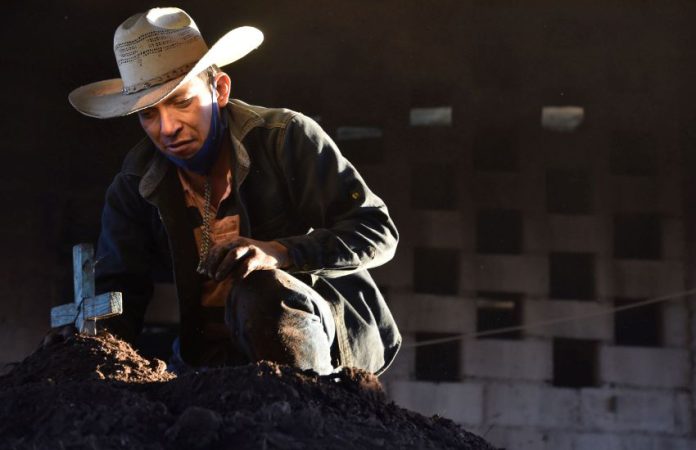Braulio García Lezama is patiently trying to explain how a maestro mezcalero — a mezcal master — knows when the heart of an agave, called a piña, is ready to be cut and used to make mezcal.
“The shape of the piña changes when it is ready,” he said. “One needs to look. It takes two to three [years] for a person to learn when they are ready.”
I mention that some piñas are small, maybe 10 pounds, while others easily top 100 pounds.
“It is the maturation, not the size,” he continued. “The size does not matter. A maestro can tell from 100 meters that piñas are ready.”
When it’s clear that no amount of explaining can make me understand, he simply says, “One just knows.”
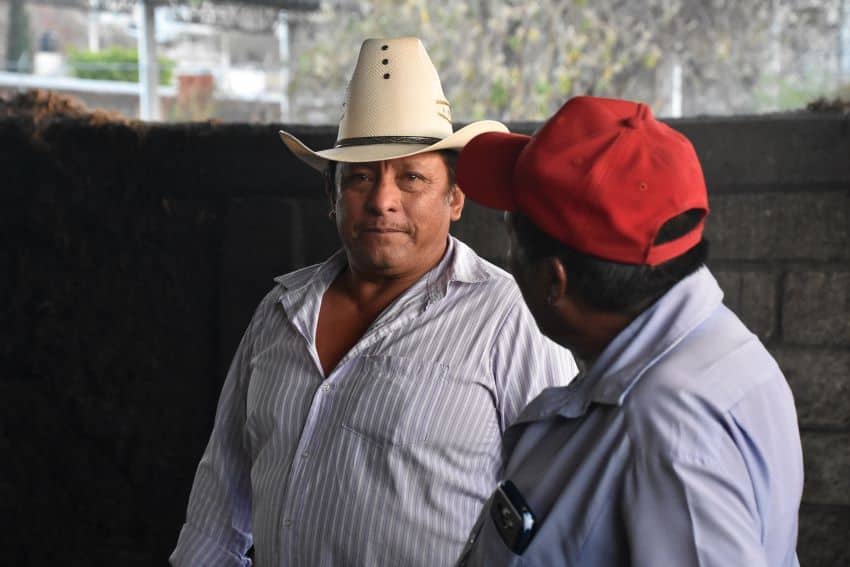
San Diego de la Mesa Tochimiltzingo, Puebla, where García lives, is a small pueblo tucked into the Sierra Mixteca, a mountain range shared by Puebla and Oaxaca. He’s a maestro who’s been making mezcal for 40 years and is the head of the cooperative Productores Unidos de Agave Tochimiltzingo. Virtually everyone in the pueblo is involved in making mezcal, an arduous task.
Juice from agave (also called maguey) has been used to make pulque — a fermented, slightly alcoholic drink — for almost 2,000 years; Los Bebedores, an 1,800-year-old mural in Cholula, Puebla, depicts people drinking pulque. It was used during celebrations and in religious ceremonies.
Mezcal, made from the same plant, is made by distilling the juice, which increases its alcohol content. There’s some debate as to whether the Aztecs and other indigenous groups distilled the juice, and it’s generally accepted that distillation was introduced by the Spanish, who had been distilling liquors since sometime in the eighth century.
While the exact date when the process was begun in Mexico may be uncertain, mezcal is known to be the first distilled liquor made in the Americas.
It’s only supposed to only be made in one of nine states: Durango, Guerrero, Guanajuato, Michoacán, Oaxaca, Puebla, San Luis Potosí, Tamaulipas and Zacatecas. This regulation, however, isn’t always followed.
San Diego de la Mesa didn’t start mezcal production until sometime in the 19th century.
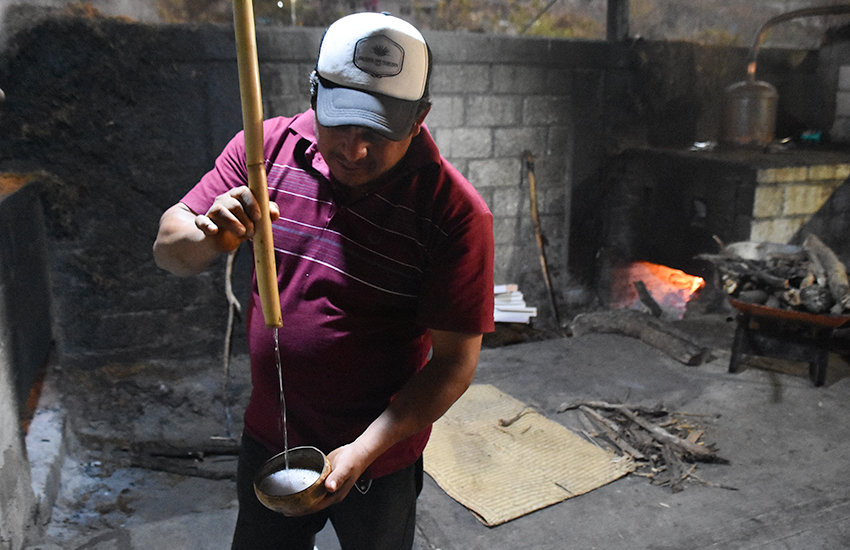
“Some people think it was first made in 1864,” said Silvistre Reyes, a mezcalero.
García put it this way. “I learned from my father, who learned from his father, who learned from his. After that, who knows?”
While tequila can only be made from blue agave, mezcal can be made from many different types.
“There are four types of agave used in San Diego de la Mesa,” said García. “But Papalometl Tobolo and Espadín Angustifolia are considered best for mezcal because they are sweeter. Here, Papalometl is considered the best.”
Papalometl has small piñas and large, broad leaves while Espadín has large piñas and narrow, tall leaves.
It takes an agave plant six to 10 years to mature. Once a maestro determines that the piñas are ready, they’re harvested weekly from December to June in San Diego de la Mesa.

“Older maguey are sweeter; smaller ones much less sweet,” said Reyes. “Different soils and different magueys yield different flavors.”
Inside a small concrete building, volcanic rocks that have been placed on blazing firewood have been heating for hours. Mezcaleros call this el horno — the oven.
“I cannot say what the temperature is,” said García. “We look at the flame. It must be between yellow and blue, then it is ready. One maestro may say, ‘Not yet,’ another, ‘It is ready.’ When everyone agrees, it is ready.”
Once that happens, the piñas are stacked around them.
The mound is first covered with palm mats and then dirt. When that’s done, a young man climbs atop the pile and is handed buckets of water, which he slowly pours through a hole in the top. Steam envelopes him. When he’s done, he’s handed a small wooden cross which he uses to plug the hole.
“The cross is put on the top to show our belief in God,” said García. “To give thanks for the harvest of agave.”
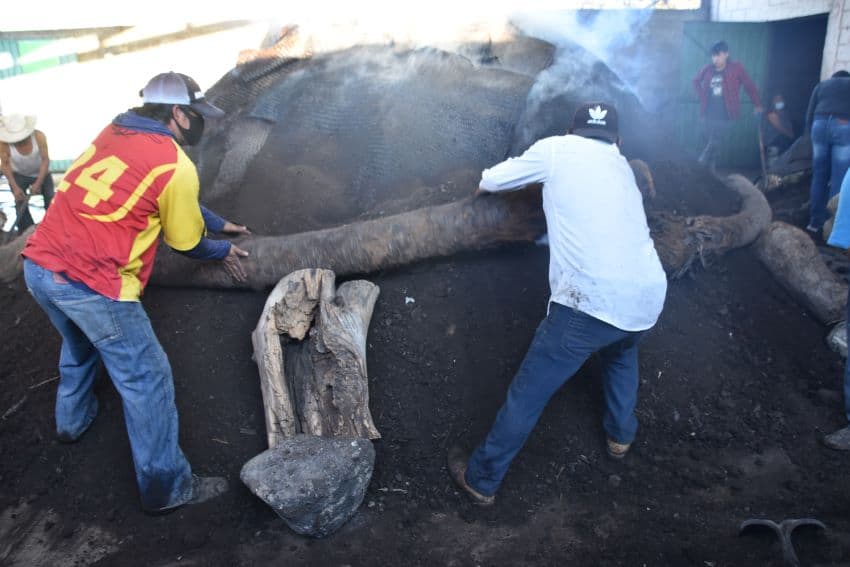
The piñas are cooked for four days — a step that gives the mezcal its intense, smoky flavor —and then left to cool for a day. When cooked, the piñas turn a dark brown. The air is filled with the smell of burned sugar.
The pile is dismantled — the piñas are tossed through the air to waiting young men — and collected in wheelbarrows. They’re chopped into small pieces, which are placed in large wooden tubs.
“Wood is better than plastic,” said García. “It gives the mezcal a better flavor. We use either pine or oak.”
Each tub contains about a tonne of maguey hearts and will yield around 80 liters of mezcal. Water, which is snow melt from Popocatépetl that has been collected in a large, deep well, is added.
“Agave and water,” said Reyes. “Nothing more.”
Large rocks placed on top — this is called a tepacite — weigh down the mixture, and it’s left to ferment for about a week.
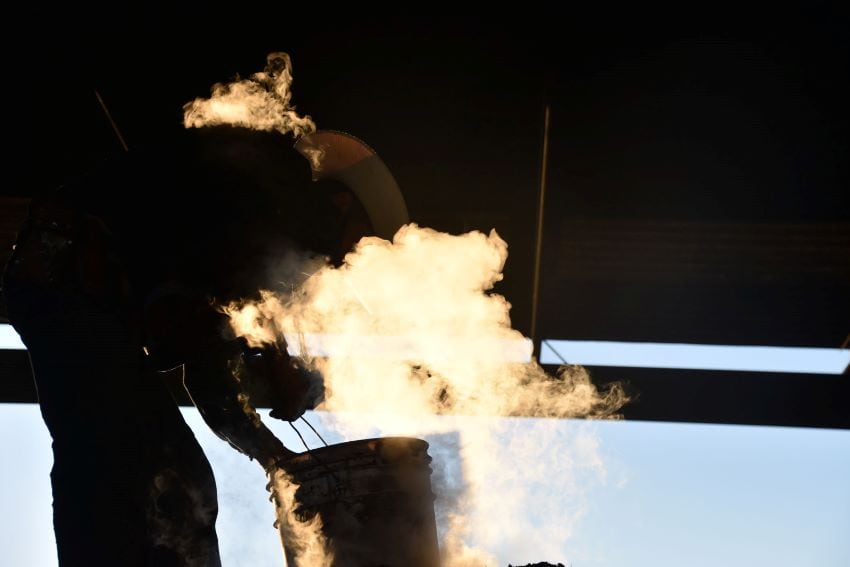
A maestro determines when the fermented liquid is ready to be distilled. A small amount of the liquid, which is dark brown at this stage, is removed with a thin tube and poured into a cup. A maestro will sip some, spit it out and be able to tell if it is ready.
“A maestro looks for the flavor,” said García. “It must be sweet and bitter. Sour is no good.”
Mezcal, like tequila, is distilled twice. The fermented liquid first is placed in a large still, an alambique, and heated. The vapor goes up a pipe, cools and is collected, drop by drop, in plastic containers. A smaller alambique is used for the second distillation.
To check for quality, a maestro uses a long tube to take a sample of the distillate. He’ll pour that into a small wooden cup and study the bubbles, which they call perlas — pearls.
“We check the perlas to know when it is ready,” said García. That is when the mezcal can finally be bottled.
Most mezcal in San Diego de la Mesa is white, i.e., not aged, although a three-year-old (añejo) is sometimes available. It’s strong, 75 to 100 proof (or more), and it’s best sipped slowly and in moderation, although all of the mezcal drinkers I spoke with assured me that drinking mezcal, even to excess, doesn’t cause hangovers (crudas in Mexico).
“It is drinking it with other alcohol like beer or rum that causes a cruda,” one man told me. I’m not so sure and have no desire to test the theory.
Mezcal production, like most artisanal processes in Mexico, is more art than science, dependent on knowledge handed down through generations. Every step is done under the direction of a maestro.
“It takes at least 10 years to become a maestro,” said García. “One has to know everything, from planting, when an agave is mature, the entire process through distillation. A person starts with something simple, like planting, chopping. Much later, they will learn about el horno and fermentation. These two are the most difficult.”
There’s no test to determine when a person’s ready to be called a maestro.
“One is a maestro,” García explained, “when one does not have to ask questions.”
Joseph Sorrentino, a writer, photographer and author of the book San Gregorio Atlapulco: Cosmvisiones and of Stinky Island Tales: Some Stories from an Italian-American Childhood, is a regular contributor to Mexico News Daily. More examples of his photographs and links to other articles may be found at www.sorrentinophotography.com He currently lives in Chipilo, Puebla.
